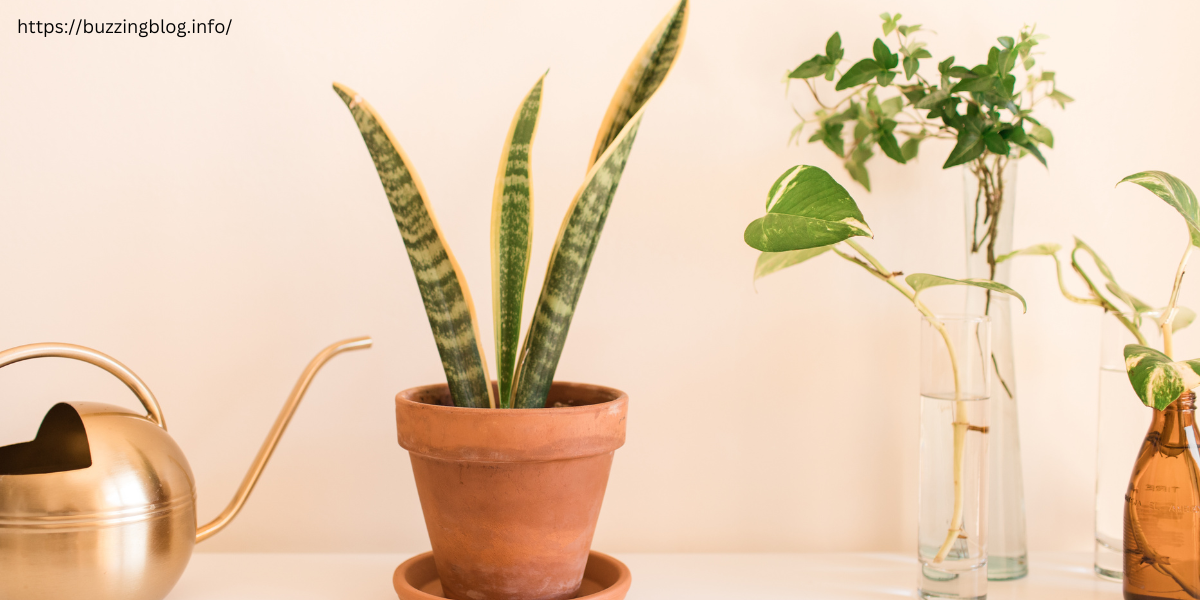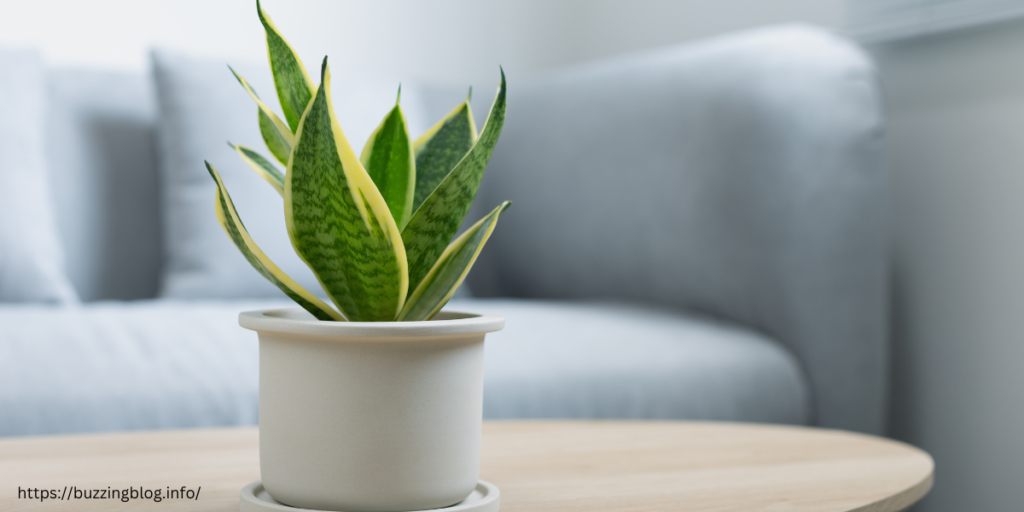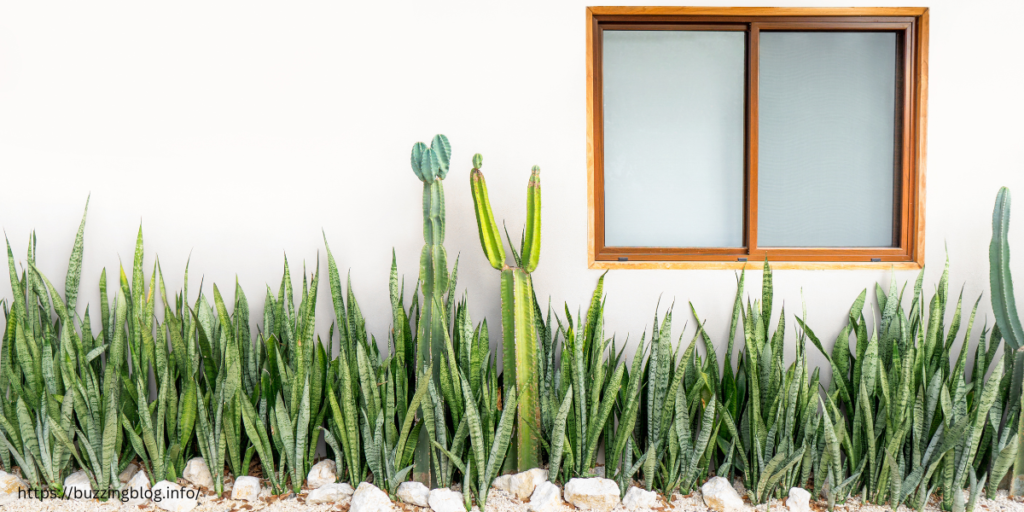Sansevieria trifasciata ‘Laurentii’ – Your Air-Purifying Houseplant
The Sansevieria trifasciata ‘Laurentii’, often called the Snake Plant or Mother-in-Law’s Tongue, is a popular houseplant known for its striking appearance and resilience. Its sword-shaped leaves, edged in vibrant yellow, make it a stylish addition to any home or office.
This low-maintenance plant thrives in various light conditions, from bright indirect light to low-light environments. It’s also quite tolerant of neglect, making it perfect for busy individuals. To care for your Laurentii Snake Plant, simply water it infrequently, allowing the soil to dry out completely between waterings.
Beyond its aesthetic appeal, the Sansevieria trifasciata ‘Laurentii’ is a natural air purifier, removing toxins like formaldehyde and benzene from the air. So, not only does it look great, but it also contributes to a healthier indoor environment.
Overview and Key Features of Sansevieria trifasciata ‘Laurentii’
The Sansevieria trifasciata ‘Laurentii’, commonly known as the Snake Plant or Mother-in-Law’s Tongue, is a popular houseplant renowned for its striking appearance and resilience. It’s a versatile plant that can thrive in various indoor environments, making it a great choice for both novice and experienced plant owners.

Key Features of Sansevieria trifasciata ‘Laurentii’:
- Unique Foliage: The plant’s most distinctive feature is its sword-shaped leaves, often variegated with striking yellow-green margins. This unique foliage pattern adds a touch of elegance to any interior space.
- Air-Purifying Qualities: Sansevieria trifasciata ‘Laurentii’ is a natural air purifier, effectively removing toxins like formaldehyde and benzene from the air. This makes it an ideal choice for improving indoor air quality.
- Low-Maintenance: One of the primary reasons for its popularity is its low-maintenance nature. It can tolerate neglect, making it perfect for busy individuals or those who are not experienced plant caretakers.
- Adaptability to Various Light Conditions: The plant can thrive in both bright, indirect light and low-light conditions. This adaptability makes it suitable for a wide range of indoor spaces.
- Tolerance to Drought: Sansevieria trifasciata ‘Laurentii’ is drought-tolerant, meaning it can withstand periods of dryness without significant damage. It’s essential to avoid overwatering, as this can cause root rot.
With its striking appearance, air-purifying abilities, and low-maintenance nature, the Sansevieria trifasciata ‘Laurentii’ is an excellent choice for anyone seeking a stylish and practical houseplant. Whether you’re an experienced plant lover or a beginner, this plant is sure to delight.
Natural Habitat and Origins of Sansevieria trifasciata ‘Laurentii’
The Sansevieria trifasciata ‘Laurentii’ traces its origins to the arid and semi-arid regions of tropical West Africa, particularly Nigeria and the Congo. In its native habitat, it thrives in rocky, dry soils and often grows in full sun or partial shade.
Adapting to Harsh Conditions To survive in these challenging conditions, the Sansevieria trifasciata ‘Laurentii’ has evolved several adaptations:
- Succulent Leaves: Its thick, fleshy leaves store water, allowing the plant to endure periods of drought.
- Shallow Root System: The plant’s root system is shallow and spreads horizontally, enabling it to absorb moisture efficiently from the soil’s surface.
- Waxy Cuticle: A waxy coating on the leaves helps to reduce water loss through transpiration.
These adaptations make the Sansevieria trifasciata ‘Laurentii‘ a remarkably resilient plant, capable of thriving in a wide range of environments. Its ability to survive in harsh conditions has contributed to its popularity as a houseplant, as it requires minimal care and can tolerate neglect.
Ideal Growing Conditions for Sansevieria trifasciata ‘Laurentii’
The Sansevieria trifasciata ‘Laurentii’ is a remarkably adaptable plant that can thrive in a variety of indoor conditions. However, providing the optimal growing conditions will help it reach its full potential.
Light:
- Tolerant of Low Light: This plant is incredibly tolerant of low-light conditions, making it suitable for dimly lit rooms.
- Bright, Indirect Light: While it can tolerate low light, it will grow more vigorously and develop more vibrant colors when placed in bright, indirect light.
Water:
- Infrequent Watering: Overwatering is a frequent mistake that may result in root rot.
- Allow Soil to Dry Out: Water your plant only when the top inch of soil feels dry to the touch.
- Drainage: Make sure the pot has sufficient drainage holes to avoid waterlogging.
Temperature:
- Warm Temperatures: The plant prefers warm temperatures, ideally between 65°F and 85°F (18°C to 30°C).
- Avoid Cold Drafts: Protect it from cold drafts, as they can damage the leaves.
Humidity:
- Low Humidity: The Sansevieria trifasciata ‘Laurentii’ can tolerate low humidity levels, making it suitable for dry indoor environments.
By providing these ideal growing conditions, you can ensure that your Sansevieria trifasciata ‘Laurentii’ remains healthy, vibrant, and a stunning addition to your home.
Light and Temperature Needs for Sansevieria trifasciata ‘Laurentii’
Light Requirements
- Tolerant of Low Light: One of the most appealing aspects of the Sansevieria trifasciata ‘Laurentii’ is its ability to thrive in low-light conditions. It can easily adapt to dimly lit corners of your home or office.
- Benefits of Bright, Indirect Light: While it can tolerate low light, placing your plant in bright, indirect light can enhance its growth and color development. The leaves may become more vibrant and the plant may grow more vigorously.
Temperature Preferences
- Warm Temperatures: The Sansevieria trifasciata ‘Laurentii’ prefers warm temperatures, ideally between 65°F and 85°F (18°C to 30°C). It can tolerate slightly higher temperatures, but extreme heat can stress the plant.
- Avoid Cold Drafts: Protect your plant from cold drafts, as they can damage the leaves and hinder growth.
- Winter Care: During the winter months, it’s important to keep the plant away from cold windows and radiators.
Soil, Watering, and Fertilization Tips for Sansevieria trifasciata ‘Laurentii’

Soil Requirements
- Well-Draining Soil: The most crucial factor for the health of your Sansevieria trifasciata ‘Laurentii’ is well-draining soil.
- Potting Mix: A well-draining potting mix that contains a combination of perlite, pumice, or coarse sand will help prevent waterlogging.
Watering Guidelines
- Infrequent Watering: Overwatering is a common cause of death for this plant.
- Allow Soil to Dry Out: Water your plant only when the top inch of soil feels dry to the touch.
- Avoid Waterlogging: Excess water can lead to root rot, so ensure your pot has adequate drainage holes.
Fertilization Needs
Avoid Over-Fertilizing: Too much fertilizer can burn the roots, so it’s important to follow the recommended dosage.
Low-Fertilizer Needs: Sansevieria trifasciata ‘Laurentii’ is a low-maintenance plant that doesn’t require frequent fertilization.
Balanced Liquid Fertilizer: During the growing season (spring and summer), you can fertilize your plant once or twice a month with a balanced liquid fertilizer diluted to half strength.
Common Issues and Solutions for Sansevieria trifasciata ‘Laurentii’
Despite its resilience, the Sansevieria trifasciata ‘Laurentii’ can sometimes encounter common issues.Below are some common problems along with their solutions:
Overwatering
- Symptoms: Yellowing leaves, soft and mushy stems, and a foul odor.
- Solution: Reduce watering frequency and ensure the pot has adequate drainage. Let the soil dry out fully between waterings.
Underwatering
- Symptoms: Brown and crispy leaf tips.
- Solution: Increase the frequency of watering, but avoid overwatering. Keep the soil evenly moist, but avoid making it overly wet.
Pests and Diseases
- Mealybugs and Scale: These pests can infest the plant, causing stunted growth and discolored leaves.
- Solution: Treat the infestation with insecticidal soap or neem oil.
Root Rot
- Symptoms: Yellowing leaves, soft and mushy stems, and a foul odor.
- Solution: Repot the plant in fresh, well-draining soil. Remove any rotten roots and treat the plant with a fungicide.
By following these guidelines and addressing common issues promptly, you can ensure that your Sansevieria trifasciata ‘Laurentii’ remains healthy and thriving
Propagation Methods for Sansevieria trifasciata ‘Laurentii’
Sansevieria trifasciata ‘Laurentii’ is relatively easy to propagate using a few different methods:
1. Leaf Cuttings
- Method 1: Water Propagation
- Cut a healthy leaf from the mother plant, ensuring it has a clean cut at the base.
- Place the bottom portion of the leaf in a jar or glass of water, ensuring only a small part of the leaf is submerged.
- Place the jar in bright, indirect light.
- Change the water every week or two to prevent algae growth.
- Once roots develop, plant the cutting in well-draining potting mix.
- Method 2: Soil Propagation
- Cut the leaf into 2-3 inch sections, ensuring each section has a node (a small bump or bump) at the base.
- Allow the cuttings to dry for a few days to form a callus.
- Plant the cuttings in a well-draining potting mix, burying the base of the leaf slightly.
- Place the pot in a warm, bright location.
- Maintain the soil slightly moist, but avoid making it soggy.
2. Division
- Gently remove the plant from its pot.
- Separate the offsets or pups from the mother plant, ensuring each division has roots.
- Place each division in its own pot filled with well-draining potting soil.
- Water the newly potted plants thoroughly.
Note: While leaf cuttings are a common method, keep in mind that variegated varieties like ‘Laurentii’ may lose their variegation when propagated through leaf cuttings. Division is often a more reliable method to preserve the unique leaf pattern.
By following these methods, you can easily propagate your Sansevieria trifasciata ‘Laurentii’ and create new plants to share with friends or decorate your home. Sources and related content
Pet Safety and Toxicity Concerns with Sansevieria trifasciata ‘Laurentii’
While the Sansevieria trifasciata ‘Laurentii’ is a popular houseplant, it’s important to be aware of its potential toxicity to pets.

Toxicity Levels
The plant contains saponins, which can cause mild to moderate toxicity if ingested by pets. Symptoms of ingestion may include:
- Gastrointestinal upset: nausea, diarrhea, and decreased appetite
- Oral irritation: Excessive drooling
- Lethargy
Keeping Pets Safe
To protect your furry friends, consider these precautions:
- Keep Out of Reach: Place the plant in a location inaccessible to your pets.
- Supervise Pets: Keep a close eye on your pets, especially if they have a history of chewing on plants.
- Consult a Veterinarian: If you suspect your pet has ingested any part of the plant, contact your veterinarian immediately for guidance.
Remember, prevention is key. By taking these simple precautions, you can ensure the safety of your pets and enjoy the beauty of your Sansevieria trifasciata ‘Laurentii’.
Benefits and Popularity of Sansevieria trifasciata ‘Laurentii’ in the U.S.
The Sansevieria trifasciata ‘Laurentii’, often referred to as the Snake Plant or Mother-in-Law’s Tongue, has gained significant popularity in the United States for several reasons:
Air-Purifying Qualities
- NASA Clean Air Study: This plant was included in NASA’s Clean Air Study, which identified it as one of the top air-purifying plants.
- Removal of Toxins: It effectively removes toxins like formaldehyde, benzene, and xylene from indoor air.
Low-Maintenance Nature
- Tolerance to Neglect: This plant is incredibly resilient and can thrive in low-light conditions and infrequent watering.
- Ideal for Busy Lifestyles: Its low-maintenance nature makes it perfect for busy individuals who may not have much time to dedicate to plant care.
Aesthetic Appeal
- Unique Foliage: Its striking, sword-shaped leaves with yellow-green margins add a contemporary touch to any interior.
- Versatile Plant: It can be used as a standalone statement piece or grouped with other plants to create a lush display.
Feng Shui Benefits
- Positive Energy: In Feng Shui, the Sansevieria trifasciata ‘Laurentii’ is believed to bring positive energy and good luck to the home.
- Harmonious Energy Flow: Its upright growth pattern is thought to promote a harmonious flow of energy.
Due to these numerous benefits, the Sansevieria trifasciata ‘Laurentii’ has become a popular choice among American homeowners and plant enthusiasts. Its combination of beauty, resilience, and air-purifying abilities makes it a valuable addition to any home or office.
General Questions
1. What is the common name for Sansevieria trifasciata ‘Laurentii’?
- It’s commonly known as the Snake Plant or Mother-in-Law’s Tongue.
2. Is the Snake Plant toxic to pets?
- Yes, the Snake Plant is mildly toxic to pets. If ingested, it can cause mild gastrointestinal upset.
3. How often should I water my Snake Plant?
- Water your Snake Plant infrequently, only when the top inch of soil is dry. Overwatering can lead to root rot.
Care and Maintenance
1. How much light does a Snake Plant need?
- Snake Plants can tolerate low-light conditions but thrive in bright, indirect light.
2. Can I propagate my Snake Plant?
- Yes, Snake Plants can be propagated through leaf cuttings or division.
3. Why are the tips of my Snake Plant turning brown?
- Brown leaf tips are often a sign of underwatering, overwatering, or low humidity. Adjust your care routine accordingly.
Benefits and Uses
1. Does the Snake Plant purify the air?
- Yes, Snake Plants are effective air purifiers, removing toxins like formaldehyde and benzene from the air.
2. Is the Snake Plant a good plant for beginners?
- Absolutely! Snake Plants are extremely low-maintenance and can tolerate neglect.
3. Can I use a Snake Plant in my bedroom?
Yes, Snake Plants are great for bedrooms as they release oxygen at night, improving air quality.










Post Comment